What Are PFAS + What Products Contain Toxic Levels?
Per- and polyfluorinated substances, synthetic chemicals linked to cancer, are commonly used in waterproofing and as nonstick coatings. PFAS contamination of water and soil pose serious health risks. While these "forever chemicals" are pervasive, there are steps you can take to reduce your exposure.

PFAS Explained
According to the Environmental Working Group, more than 200 million Americans could be exposed to drinking water with unsafe levels of per- and polyfluoroalkyl substances. What are PFAS?
Also called “forever chemicals,” PFAS are synthetic chemicals often used when manufacturing products such as water-repellent clothing and nonstick cookware. PFAS can take thousands of years to degrade and National Toxicology Program research links high levels of PFAS exposure with health issues such as cancer and immune system dysfunction.
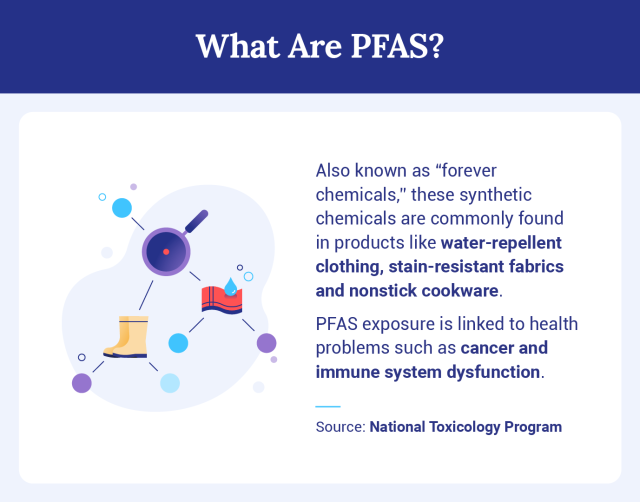
Most research on PFAS focuses on perfluorooctane sulfonic acid, perfluorooctanoic acid, perfluorononanoic acid and perfluorohexane sulfonic acid. PFOA and PFOS are now prohibited in the U.S., but new PFAS were created to take their place in the manufacturing process.
While PFAS are all around us, not many people know the risks of exposure. Use our guide to learn what products commonly contain PFAS and how you can limit your exposure to them.
PFAS in Commercial Products
PFAS are commonly used as a repellent for grease or water. Their anti-grease properties make using PFAS as a coating popular on nonstick pans, pizza boxes, microwave popcorn bags and kitchen utensils such as spatulas. As a water repellent, PFAS are used in athleisure wear, raincoats and car upholstery, for example.
Here’s a breakdown of a few common products that contain PFAS:
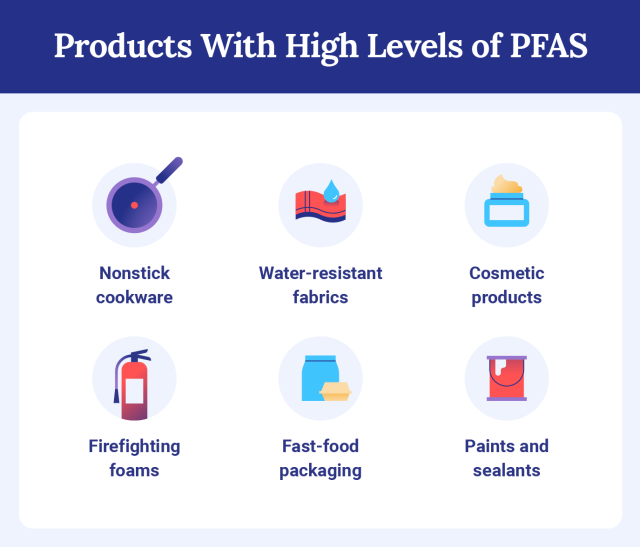
While the use of PFOS and PFOA is regulated in commercial products, other PFAS are being created to replace them. These products can leach chemicals and be ingested. PFAS products in landfills and factories producing PFAS products can contaminate nearby air, water and soil.
Cleaning products
An Environmental Pollution study found that childcare facilities that mopped daily had high levels of fluorotelomer sulfonates — a type of PFAS commonly found in cleaners and waxes. This suggests that cleaning products could expose children to the dangerous chemicals, as young kids often crawl and play on the floor.
To avoid PFAS contamination around your home, search for cleaning products that are Green Seal verified. Cities including Philadelphia, Los Angeles and Chicago and states such as Colorado and Pennsylvania have worked with Green Clean Educational institutions such as the University of Miami and business organizations such as the World Bank have as well.
Cosmetic Products
Cosmetic products will often use PFAS to increase water resistance and durability. In 2021, Environmental Science and Technology Letters tested 231 cosmetic products for fluorinated compounds. High levels of fluorine would indicate that PFAS are likely present.
Of the cosmetics tested, they found the highest levels of fluorine in foundations, concealers, lip products and other face products such as blush, bronzers and powders. When they tested products with the highest fluorine levels, all of them contained at least four types of harmful PFAS. The majority of the products analyzed had no PFAS listed on their labels.
Fast-Food Packaging
To make fast-food packaging resistant to grease, companies will often add PFAS. These chemicals can contaminate your food via direct contact and are then ingested. Additionally, PFAS transfer more easily from packaging to foods with high fat or salt content, making many types of fast food particularly susceptible to contamination.
One way to reduce your PFAS exposure is to cook more meals at home. A 2019 study found higher PFAS levels in people who consumed meals from fast-food restaurants and other dining establishments, whereas people who consumed foods at home had lower levels.
Firefighting Foams
People who live near a landfill, industrial site or fire training site are at greater risk of PFAS exposure. Products in landfills can leach PFAS into the soil and waterways. Spills and gas emissions at industrial sites can pollute nearby areas. And PFAS in firefighting foam can runoff and contaminate wells and other drinking water sources.
In June 2023, 3M one of the largest makers of firefighting foam, agreed to pay up to $12.5 billion dollars to settle lawsuits filed over the contamination of public water systems across the country.
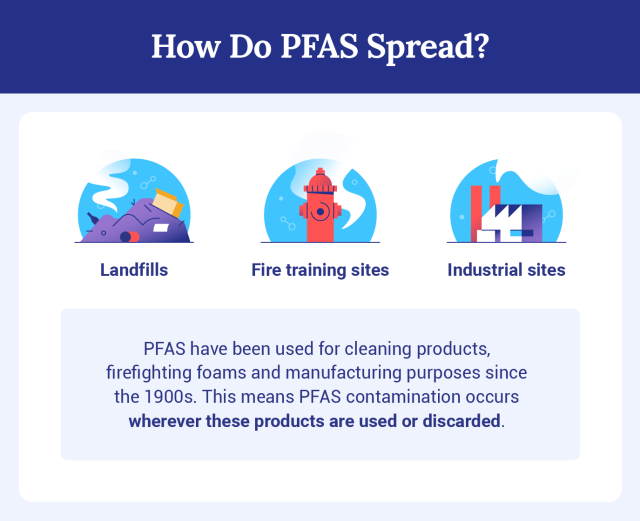
PFAS are added to firefighting foams to help them spread and suppress fires, but when these chemicals seep into our environment and groundwater, people and wildlife are put at risk. To prevent contamination, encourage your local fire department to transition to PFAS-free alternatives. California is one of the first states to pass legislation to phase out the use of PFAS in firefighting foams, but most states still allow them.
Nonstick Cookware
Many nonstick pans are treated with PFAS, which can contaminate your food when you scratch the pan or heat it too high. Using PFAS-free cookware, such as cast iron skillets, stainless steel or ceramic-coated pans can help you avoid PFAS contamination.
Paints and Sealants
Paints and sealants often use PFAS to improve their spread and stain-resistance and to decrease peeling and bubbling. While most paints contain either volatile organic compounds or PFAS, there are alternatives that don’t spread contamination. Look for Green Seal verified paint or VOC and PFAS free on the label.
Water-resistant Fabrics
A 2022 Toxic-Free Future study tested outdoor apparel, bedding, tablecloths and napkins from 10 major retailers and found that 72% of products marketed as stain- or water-resistant contained PFAS. In contrast, all of the items that weren’t marketed as stain- or water-resistant were PFAS-free.
As companies become aware of the dangers of PFAS, PFAS-free alternatives are becoming more common. For example, brands like Deuter and Didriksons only sell PFAS-free products, including water-resistant backpacks and jackets.
Drinking Water
PFAS are one of many sources of water contamination in the U.S. In 2019, the EWG tested levels of PFAS in tap water in locations across 31 states. All but one location tested were contaminated with PFAS. All but two of those remaining locations had PFAS levels high enough to be linked to health risks.
Freshwater Fish
Recent research from the scientific journal Environmental Research found that PFAS have contaminated freshwater fish across the U.S. in large quantities. In a serving of fish, an average of 48 parts per trillion of PFAS were detected. This means that eating one serving of fish equates to drinking about a month’s worth of contaminated water.
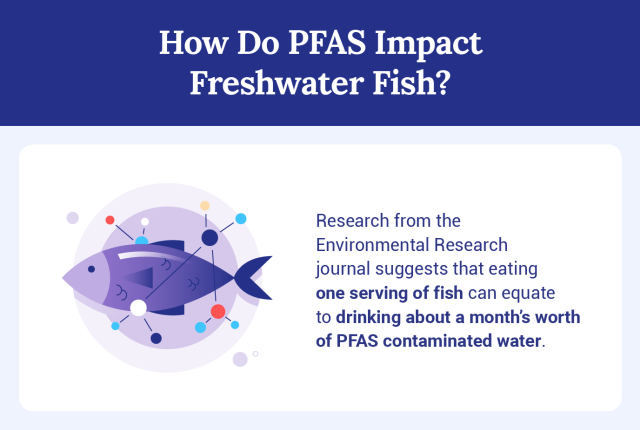
States such as Michigan have begun creating guides for people to know which sources and types of fish have been found to have higher PFAS levels and tips for finding fish with lower levels. Michigan’s Eat Safe Fish in Michigan advises people to opt for small types of fish, avoid bottom feeders, remove as much fat as possible and cook on a rack to allow even more fat that may be PFAS contaminated to drip away from the fish.
Ways To Protect Yourself
It can be difficult to avoid PFAS. Knowing what to look for on product labels and learning as much as possible about the quality of your drinking water can help you reduce your PFAS exposure.
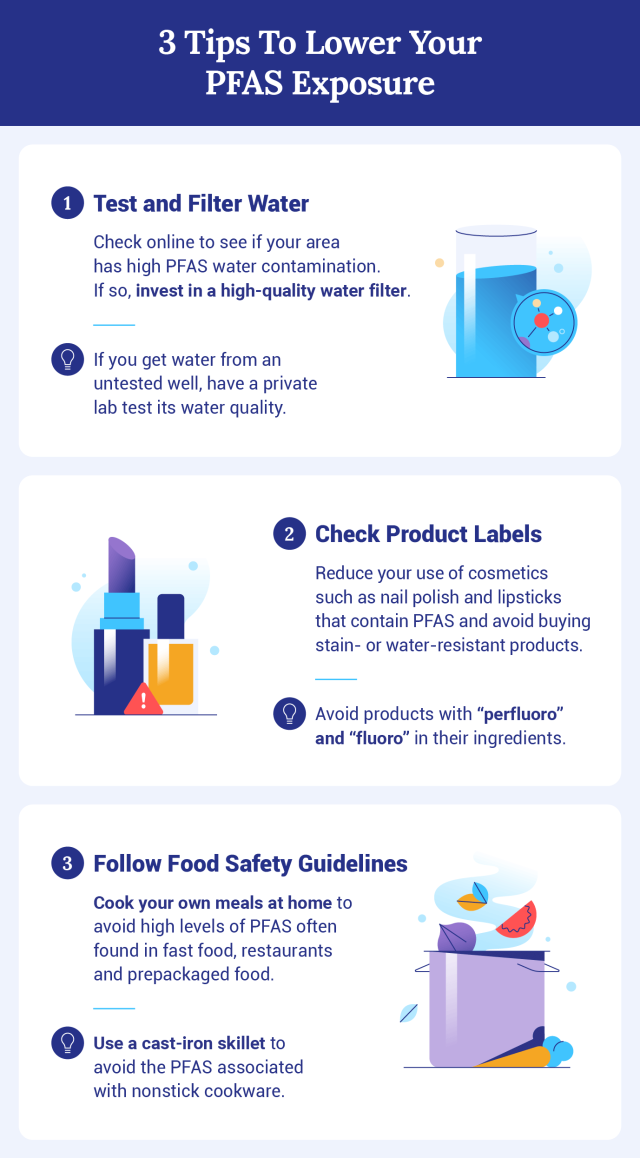
Following the best practices outlined below can help limit your exposure to PFAS and their harmful effects on your health.
1. Test and Filter Water
Drinking water is one of the main ways we are exposed to PFAS. Check the EWG’s contamination map to see if you live in a location with safe drinking water. The Environmental Protection Agency recommends reaching out to your local water utility for more information about your water supply or use a state-certified laboratory to test your water.
If you live in a location with unsafe drinking water, it’s a good idea to invest in a high-quality water filter. The Minnesota Department of Health notes that filters with activated carbon and reverse osmosis are effective in removing PFAS.
2. Check Product Labels
Common sources of PFAS exposure include water-resistant clothing, nonstick cookware and cosmetic products. Avoid buying these products or any products containing ingredients with “perfluoro” or “fluoro” in their name. Look for PFAS-free on labels.
3. Follow Food Safety Guidelines
A 2019 study from Environmental Health Perspectives found that consumption of fast food, restaurant food and microwave popcorn was linked to higher levels of PFAS contamination.
To reduce your risk, look for microwave popcorn bags that state they’re PFAS free, transfer takeout from its packaging to your own containers or dishes quickly or cook your own meals at home with fresh ingredients when possible. This can help you prevent exposure to not only PFAS, but a variety of chemicals. Foods contaminated with glyphosate, commonly found in weed killers may also have adverse health effects, for example.
4. Support PFAS-Free Alternatives
A handful of brands go out of their way to make PFAS-free versions of products that traditionally contain PFAS. When you refuse to buy products with PFAS, you’re helping spread the message to brands that these chemicals are unacceptable.
What Are the Health and Environmental Risks?
PFAS don’t just impact humans — they’ve spread to wildlife, our soil and even polluted the air. EWG research found PFAS in 330 animal species across the world, including endangered species such as tigers and pandas. Recent research suggests that PFAS could have similar health impacts on animals and humans.
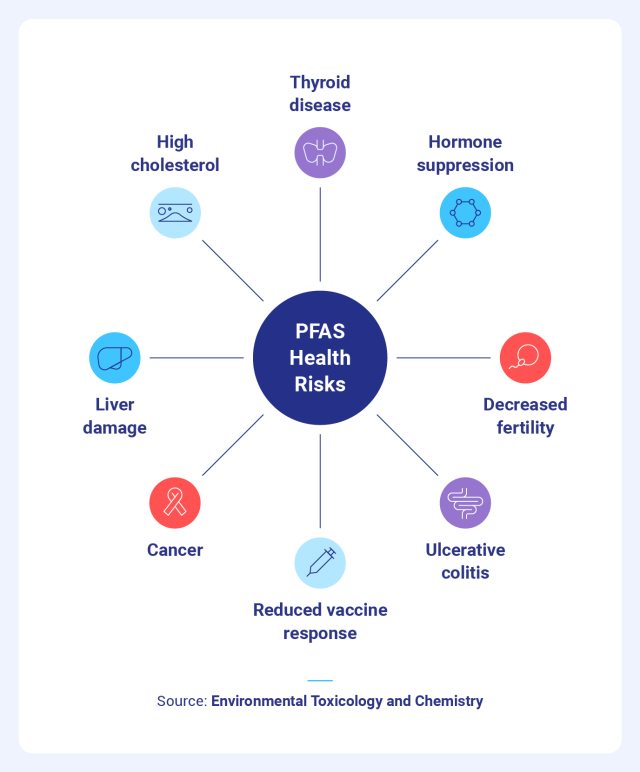
In 2022, the journal Frontiers in Toxicology tested PFAS levels in alligators from the Cape Fear River in North Carolina, known for its high level of pollution from the nearby Chemours chemical plant. Compared to alligators from a nearby population in the Lumber River basin, those in Cape Fear had significantly higher levels of PFAS concentration in their blood.
The Cape Fear alligators also showed rates of interferon-alpha responsive genes at levels 400 times higher than the reference group. This gene is commonly linked to autoimmune diseases in humans.
Current research links exposure to PFAS with potential health effects such as:
- Cancer
- Decreased fertility
- High cholesterol
- Hormone suppression
- Thyroid disease
- Liver damage
- Ulcerative colitis
Additionally, the Cape Fear alligators showed higher numbers of unhealed or infected lesions, suggesting disruptions in their immune system’s functionality. This suggests that PFAS are a danger to both humans and animals.
Are You Exposed to PFAS?
Since PFAS are manufactured at large scales and don’t break down for thousands of years, you’ve likely been exposed. CDC research in 2012 found PFOA, PFOS, PFHxS and PFNA in 97% of American blood samples tested.
These forever chemicals are widespread in the air, soil and water. You could be exposed when eating food grown in PFAS-contaminated soil, drinking contaminated water or breathing contaminated air.
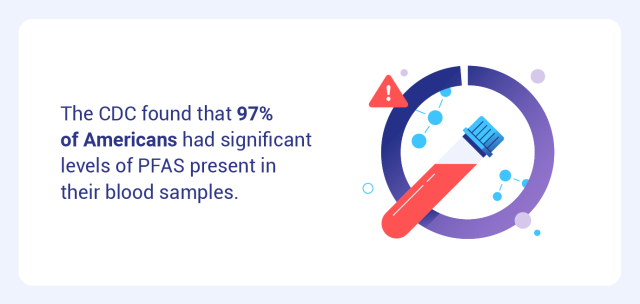
Those most at risk for PFAS contamination are workers in facilities that manufacture PFAS. When the blood of manufacturing workers was tested in 1998, their blood levels contained PFOS at 941 micrograms per liter of blood.
The general U.S. population in 1999 measured 30.4 micrograms per liter. That means the manufacturing workers had PFOS levels more than 96% higher than the average U.S. citizen.
PFAS and the Military
A 2022 analysis found that at least 116 military sites contained potentially unsafe levels of PFAS in drinking water, exceeding the EPA-advised limit. That equates to more than 600,000 military service members who likely face contamination.
Contamination at military bases is likely because of the use of firefighting foams. Outside factors such as industrial contamination can play a role as well. If you worked at Camp Lejeune, a base with high levels of toxic drinking water, between 1953 and 1987, you likely qualify to file a lawsuit to receive compensation.
Key Takeaways
For more information about pollutants and PFAS, visit our page on environmental health. Learn more about PFAS and tips to protect yourself from exposure with the infographic below:

PFAS pose a threat to our health and the well-being of our environment. The best way to reduce your exposure is to understand where PFAS originate, how they spread and what products contain them.
18 Cited Research Articles
Consumernotice.org adheres to the highest ethical standards for content production and references only credible sources of information, including government reports, interviews with experts, highly regarded nonprofit organizations, peer-reviewed journals, court records and academic organizations. You can learn more about our dedication to relevance, accuracy and transparency by reading our editorial policy.
- Environmental Research. (2023, March 1). Locally caught freshwater fish across the United States are likely a significant source of exposure to PFOS and other perfluorinated compounds. Retrieved from https://www.sciencedirect.com/science/article/pii/S0013935122024926?via%3Dihub#fig5
- Environmental Working Group. (2022, December 15). More than 600,000 service members given ‘forever chemicals’ in drinking water. Retrieved from https://www.ewg.org/news-insights/news-release/2022/12/more-600000-service-members-given-forever-chemicals-drinking
- Guillette, T.C. et al. (2022, October 20). Blood concentrations of per- and polyfluoroalkyl substances are associated with autoimmune-like effects in American alligators from Wilmington, North Carolina. Retrieved from https://www.frontiersin.org/articles/10.3389/ftox.2022.1010185/full
- Minnesota Department of Health. (2022, October 3). PFAS and Home Treatment of Water. Retrieved from https://www.health.state.mn.us/communities/environment/hazardous/topics/pfashometreat.html
- Environmental Working Group. (2022, June). PFAS Contamination in the U.S. Retrieved from https://www.ewg.org/interactive-maps/pfas_contamination/map
- CDC.gov. (2022, March 24). Biomonitoring Data Tables for Environmental Chemicals. National Report on Human Exposure to Environmental Chemicals. Retrieved from https://www.cdc.gov/exposurereport/data_tables.html
- Chreder, E. & Goldberg M. (2022 January). Toxic Convenience:The hidden costs of forever chemicals in stain- and water-resistant products. Retrieved from https://toxicfreefuture.org/wp-content/uploads/2022/08/toxic-convenience.pdf
- Ramirez Carnero, A. et al. (2021, June). Presence of Perfluoroalkyl and Polyfluoroalkyl Substances (PFAS) in Food Contact Materials (FCM) and Its Migration to Food. Retrieved from https://www.mdpi.com/2304-8158/10/7/1443
- Whitehead, H. D. et al. (2021, June 15). Fluorinated Compounds in North American Cosmetics. Retrieved from https://pubs.acs.org/doi/10.1021/acs.estlett.1c00240
- Fenton, S.E. et al. (2020, December 7). Per- and Polyfluoroalkyl Substance Toxicity and Human Health Review: Current State of Knowledge and Strategies for Informing Future Research. Retrieved from https://www.ncbi.nlm.nih.gov/pmc/articles/PMC7906952/
- Environmental Working Group. (2020, October 14). Study: More Than 200 Million Americans Could Have Toxic PFAS in Their Drinking Water. Retrieved from https://www.ewg.org/news-insights/news-release/study-more-200-million-americans-could-have-toxic-pfas-their-drinking
- Zheng, G. et al. (2020, March). Indoor exposure to per- and polyfluoroalkyl substances (PFAS) in the childcare environment. Retrieved from https://pubmed.ncbi.nlm.nih.gov/31901805/
- Environmental Working Group. (2020, January 23). PFAS Contamination of Drinking Water Far More Prevalent Than Previously Reported. Retrieved from https://www.ewg.org/research/national-pfas-testing
- Susmann, H. P. et al. (2019, October 9). Dietary Habits Related to Food Packaging and Population Exposure to PFASs. Retrieved from https://ehp.niehs.nih.gov/doi/full/10.1289/EHP4092
- National Toxicology Program. (2016, September). Immunotoxicity Associated with Exposure to Perfluorooctanoic Acid or Perfluorooctane Sulfonate. Retrieved from https://ntp.niehs.nih.gov/ntp/ohat/pfoa_pfos/pfoa_pfosmonograph_508.pdf
- Lewis, R.C., Johns, L.E. & Meeker, J.D. (2015, May 29). Serum Biomarkers of Exposure to Perfluoroalkyl Substances in Relation to Serum Testosterone and Measures of Thyroid Function among Adults and Adolescents from NHANES 2011-2012. Retrieved from https://www.ncbi.nlm.nih.gov/pmc/articles/PMC4483690/
- Michigan Department of Community Health. (n.d.). East Safe Fish in Michigan. Retrieved from https://www.michigan.gov/mdhhs/-/media/Project/Websites/mdhhs/Safety-and-Injury-Prevention/Environmental-Health/Eat-Safe-Fish/Documents/family_fish.pdf
- Environmental Working Group. (n.d.). Global danger: Wildlife at risk from PFAS exposure. Retrieved from https://www.ewg.org/interactive-maps/pfas_in_wildlife/map/
Calling this number connects you with a Consumer Notice, LLC representative. We will direct you to one of our trusted legal partners for a free case review.
Consumer Notice, LLC's trusted legal partners support the organization's mission to keep people safe from dangerous drugs and medical devices. For more information, visit our partners page.
855-493-2793
